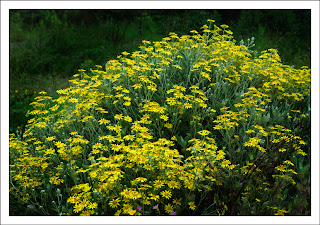“A ROSE GROWS WILD IN THE COUNTRY”
(Words and music - Peretti/ Creatore/ Weiss)
First, a statement of fact - I have been berated today for pontificating on how perfect our garden is when she tells me I am idle and she wants order, not weeds and more change as I cannot keep up with what we have. I use the continuous rain as an excuse - yes, it may be a heat wave in the south but “up north” “Still falls the rain.”
Back to being berated - so what do we do - fence off chunks and leave them to do their own thing, get someone in to strim and stuff, stop playing so much golf and sitting in front of this computer, messing with photographs and churning out blogs?
So to another blog - I have weeded the veg and fruit beds and cleared grass from the shrubs on the banking as well a violently pruning the huge broom so can justify a little blogging.
Now we are well beyond the daffodil damage time - do not cut back the leaves of spring bulbs and corms until they are over or next year’s show will be much poorer as the plants will not have time to build up reserves - we can strim the long grass. (Or someone else can.)
One Council not far south from here planted thousands of crocuses in the grass strips between the road and pavement on the road leading into the town. Then they mowed them as soon as the fantastic display was done. Next year the show was poor and finally zero. What a waste.
Now, I have inadvertently strimmed trees and killed them (wrists slapped) by effectively ring barking them. (Taking a strip of bark from a tree trunk all the way around will kill all growth above that point.) The lads working on our local golf course regularly kill young trees by doing this. Sigh!
 Some local Councils have sense and only cut back verges enough to ensure safety for traffic and leave the rest - a wonderful habitat for all sorts of flora and fauna.
Some local Councils have sense and only cut back verges enough to ensure safety for traffic and leave the rest - a wonderful habitat for all sorts of flora and fauna.Wild plants thrive in the garden, some in the wood, in the bog, in the pond, the hedges, on the grass bankings and some in the flowerbeds. Foxgloves seed themselves around the beds and are welcome - spectacular plants wherever they are (in moderation) - and they grow in the woodland. Amongst the trees and in the long hedge there are wild dog roses (which I do prune when they get out of hand - you can be ecologically sound (whatever that means) and still exert some sort of control).
We have the wild Alchemilla mollis (Lady’s Mantle) as well as the garden kind. There is a difference - the leaves of the wild sort are not so hairy and the plant is less bulky. The third sort - Alpine and much smaller - we do not have.
When, years ago, I worked in Southport (it was YEARS ago), and my wife worked in Woodvale, she used to take the back road from Pilkington Road, where we lived, and this ran across an area of waste land covered in tree lupins growing wild. They were yellow and for some years, in previous gardens, we grew them. In our current garden we have the white variety, which can be very beautiful. R says she does not like the way it turns pink/mauve as it ages. We also grow Evening Primroses for their wonderful yellow. They grow all along the shore and dunes around Southport.
Some weeds were once medicines - time for a poem.
WOUNDWORT
i
In the marshy edge,
where vegetation hesitates,
Woundwort sends spires
of pink through the shade.
The hollow stems are brittle
and, if crushed, smell strongly.
Its leaves are nettle-like
but have no sting.
ii
In Kent a poor man scything Peason
sliced his leg to the bone.. He crept to
some Woundwort, bruised it with his rough hands,
tied a bundle ‘round the gaping cut
and secured it with a piece of shirt.
Day by day he poulticed it with stems
stamped in lard - was cured. Gerard saw this,
and thought that he had found an all-heal.
iii
Mr E Cartwright of Graye’s Inn, Holborne,
who had been thrust through the lung and stomach
by himself, was found dying in his bed
with a frothing discharge staining his shirt.
John Gerard, herbalist, gave him drink, found
one wound leaked - the other snuffed a candle.
He took the leaves of All Heale and stamped them
with hog’s grease, strapped a tight poultice
to the chest of the injured, healed him.
iv
In the woodland edge,
Woundwort is a wild flower.
Flowers, six round the stem,
taper to the top; long
lower lips kissed with white
bend under bee weight.
Once it was a cure,
Gerard’s all-heal.
(after 1. Geoffrey Grigson, The Englishman’s Flora,
2. John Gerard, Gerard’s Herbal.)
I suppose growing up on a Lake District farm and roaming wild, plus an interest in botany from my pram years, (thanks Mum), instilled a love of nature. Days spend creating tunnels in high bracken, mucking about by the lake or in becks, climbing hills or just wandering in the woods must have influenced me.
I like to take a little of my childhood (R would say all of it) with me as I get older.
So, there you are, I do not need to return to my childhood as I age, I never left it!

















